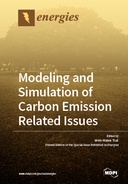Explore

Modeling and Simulation of Carbon Emission Related Issues
Wen-Hsien Tsai
2019
0 Ungluers have
Faved this Work
Login to Fave
Carbon emissions reached an all-time high in 2018, when global carbon dioxide emissions from burning fossil fuels increased by about 2.7%, after a 1.6% increase in 2017. Thus, we need to pay special attention to carbon emissions and work out possible solutions if we still want to meet the targets of the Paris climate agreement. This Special Issue collects 16 carbon emissions-related papers (including 5 that are carbon tax-related) and 4 energy-related papers using various methods or models, such as the input–output model, decoupling analysis, life cycle impact analysis (LCIA), relational analysis model, generalized Divisia index model (GDIM), forecasting model, three-indicator allocation model, mathematical programming, real options model, multiple linear regression, etc. The research studies come from China, Taiwan, Brazil, Thailand, and United States. These researches involved various industries such as agricultural industry, transportation industry, power industry, tire industry, textile industry, wave energy industry, natural gas industry, and petroleum industry. Although this Special Issue does not fully solve our concerns, it still provides abundant material for implementing energy conservation and carbon emissions reduction. However, there are still many issues regarding the problems caused by global warming that require research.
This book is included in DOAB.
Why read this book? Have your say.
You must be logged in to comment.
Rights Information
Are you the author or publisher of this work? If so, you can claim it as yours by registering as an Unglue.it rights holder.Downloads
This work has been downloaded 254 times via unglue.it ebook links.
- 187 - pdf (CC BY-NC-ND) at Unglue.it.
Keywords
- 1))
- activity-based costing (ABC)
- agricultural-related sectors
- Aircraft
- capacity expansion
- carbon emissions
- carbon footprint
- carbon intensity
- carbon intensity target
- carbon price fluctuation
- carbon tax
- carbon trading
- causal factors
- China
- CLA Model
- Climate Change
- CO2 emissions
- CO2 emissions forecasting
- decoupling analysis
- decoupling elasticity
- economic growth
- economic growth and the environment
- electric power industry
- energy intensity
- energy structure
- Environmental impact
- error correction mechanism model
- ethylene supply
- fairness
- final energy consumption
- Generalized Divisia Index
- generalized regression neural network (GRNN)
- gray model (GM (1
- gray model (GM (1, 1))
- green manufacturing
- green quality management
- green transportation
- greenhouse gas emissions
- HOMER software
- household CO2 emissions (HCEs)
- household consumption
- hybrid genetic algorithm
- hybrid ship power systems
- Industry 4.0
- influence factor
- influencing factors
- input–output model
- inventory routing problem
- investment under uncertainty
- Li-ion battery
- Life Cycle Assessment
- long-term
- low-carbon agriculture
- LT-ARIMAXS model
- Markov forecasting model
- mathematical programming
- Monte Carlo method
- n/a
- non-energy uses of fossil fuels
- non-linear programming
- per capita household CO2 emissions (PHCEs)
- population growth
- power industry
- product-mix decision model
- pushback control
- quotas allocation
- real options analysis
- reducing carbon emissions
- refined oil distribution
- renewable energy
- scenario forecast
- shale gas
- Shipping
- socio-economic scenarios
- STIRPAT model
- Sustainable Agriculture
- Sustainable development
- takeoff rate
- Tapio’s model
- taxi time
- Tea
- Textile industry
- Tire industry
- total carbon emissions
- VARIMAX-ECM model
- wave energy converter
Links
DOI: 10.3390/books978-3-03921-312-2Editions


